Take advantage of these tools and resources to help understand cystinosis better and prepare for managing your disease as you become more independent.
Join Ruby on her quest to find and remove cystinosis crystals throughout the body in this informative animated lesson for young children. Watch and discuss the video, then continue the discussion by ordering the Quest for Crystals book.
[Background music]
The Quest for Crystals writes on screen
[VO]
Meet Ruby
She’s an explorer. She searches for crystals in a surprising place.
The place where Ruby looks for crystals is in the body! She is like medicine that takes crystals out of the body. Travel with Ruby through the body to find as many crystals as you can.
Let’s go!
Crystals can be pretty and shiny.
But crystals don’t belong in your body. It’s good to get them out.
Ruby’s first stop is the kidneys. People are born with 2 kidneys.
Kidneys help your body keep stuff it needs, like water and salt, and get rid of stuff it doesn’t need.
But kidneys have a hard time keeping the good stuff in the body if they have crystals in them.
Help Ruby find a crystal.
Do you know how kidneys get rid of the stuff you don’t need? By turning it into pee!
Wow! Look at these arm muscles!
Muscles make you strong and help you move.
But muscles are not so strong with crystals in them.
Help Ruby find a crystal.
Guess what? There are muscles all over your body—even in your throat where they help you swallow!
Ruby has crawled into the lungs. They are in your chest.
Your lungs breathe for you. They take air in and push it out of your body so your body can make energy.
The lungs also help you talk and SHOUT!
But the lungs may have some trouble working if there are crystals in them.
Are there any crystals here for Ruby to find?
Next stop, the brain!
But wait. Ruby sees something that looks like a butterfly. It’s in the neck.
It’s the thyroid. It helps your body work normally so you can grow!
But it can’t help you grow with crystals in it.
Ruby better stop and find a crystal. Can you help?
Can you guess where Ruby is now?
In the amazing brain!
The brain lets you think and feel things.
Help Ruby find a crystal so the brain can think well.
Look! Can you see where Ruby is now?
She’s in the eyes. Your eyes see the world.
But—you already know—the eyes can’t see like they should with crystals in them.
Help Ruby find a crystal.
And if you find sunglasses, give them to Ruby. It’s bright in here!
You did it!
You helped Ruby find all the crystals!
Ruby is done with her job for now. She will make another trip through the body later. She tells her friends that it's their turn.
“Get going, guys!” Ruby says. “We’ve got to keep this kid as healthy as we can!”
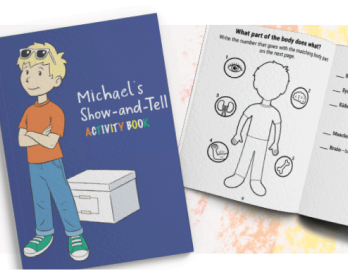
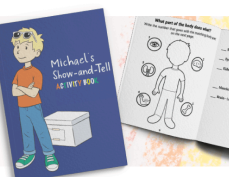
This activity book is filled with fun things for kids to do while they read and learn what it’s like for Michael to live with cystinosis. It’s a great way to start a conversation with children to help them understand cystinosis.
Start the discussion now with these downloadable coloring pages! Then keep the conversation going for years to come with a bound copy of Michael’s Show-and-Tell Activity Book.
You can check how much you and your child have learned by taking a fun interactive quiz.
Watch this animated video about siblings Michael and Andrew. Michael has cystinosis and is not feeling well enough to attend Andrew’s dress rehearsal for his piano recital. See how the entire family works together to manage disappointment and take care of each other.
[BACKGROUND MUSIC] Piano – a familiar tune, but played more slowly than usual, like a beginner is practicing. The music stops briefly, then starts again. Same song.
[MOM] Do you think you can make it to Andrew’s dress rehearsal?
[MICHAEL] I don’t think I can, mom. I feel sick.
AUDIO: Piano, stops
[MOM] Michael isn’t feeling well. We won’t be able to make the rehearsal.
[ANDREW] But you missed the last one!
[AUDIO] Piano, loud
[MOM] Andrew!
[MOM] I know the timing is terrible, but you know Michael has good days and bad. We’ll be there for the recital.
[ANDREW] Sometimes I wish I was sick too.
[MOM] Andrew is pretty upset, but Samira’s mother is going to pick him up and take him.
[MICHAEL] I hate being sick and causing problems…
[MOM] It’s not your fault, Michael.
[FRIEND] Where’s your family?
[ANDREW] My brother is not feeling well today so they couldn’t make it.
[MICHAEL] That’s a strike!
[MICHAEL] Hey, that’s my jacket!
[MUSIC] Piano continues. An off-key piano note or two interrupts the flow of the song.
[MICHAEL] I’m sorry I wasn’t feeling good and missed your dress rehearsal.
[ANDREW] It’s ok. I’m used to it.
[MICHAEL] I’d like to make it up to you with a song.
[MOM] You were awesome tonight, Andrew.
[ANDREW] How would you know?
[MOM] Samira’s mom sent me a video of your performance.
[ANDREW] That’s not the same as being there.
[MOM] I know.
[MOM] Would you mind playing your song now?
[ANDREW] Well. I am a little tired. But Ok.
[Piano] Same song, taken from the top
©2023 HORIZON THERAPEUTICS PLC DA-UNBR-US-01279 04/23
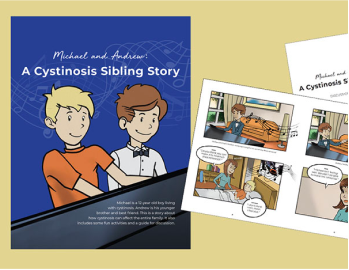
Michael is a 12-year-old boy living with cystinosis. Andrew is his brother and best friend. Read this animated comic to see how the entire family works together when Michael is not feeling well enough to attend Andrew’s dress rehearsal for his piano recital. It also includes some fun activities and a guide for discussion.
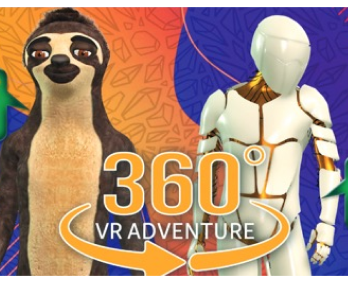
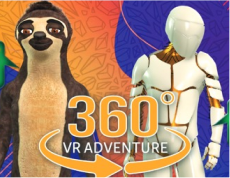
Looking for a fun way for your child to learn more about cystinosis? Encourage your child to join Rapido the Sloth and Remmy the Robot on some fun adventures in a virtual reality experience designed to support them in their management of cystinosis.
Do you or your child ever get tired of explaining to others what cystinosis is and how it affects you? Here is a video called, “I Live with Cystinosis” you can share with others to do the explaining for you or your child!
Share video[MUSIC] Light, unobtrusive background music
[PATIENT] I live with cystinosis. It’s a rare genetic disorder affecting only about 500 to 600 people in the United States.
I am rare. And guess what? So are you! Not many people get to meet a person with cystinosis!
I want you to know about my symptoms and side effects that happen because of my disease and the medicine I take to treat it. Fortunately, cystinosis can be managed.
I experience sensitivity to light. Cystinosis causes cystine crystal formation in my eyes. I often wear sunglasses to help with the light.
I am sensitive to heat because cystinosis impairs my ability to sweat. I try not to be too active in warm rooms or when it’s hot outside.
I may have to miss out on things if I have doctor appointments, if I’m feeling sick, or when serious things come up and I have to go to the hospital.
I sometimes experience low energy levels. Snacking frequently during the day helps.
I sometimes experience near-constant thirst because cystinosis causes dehydration.
I carry a water bottle and I have to go to the bathroom frequently.
I know it’s really important for me to take my medicine. But sometimes the medicine causes me to have bad breath or body odor. I eat mints, chew gum, or apply essential oils to try to help.
I work hard to manage my disease and have since I was a little kid. It’s important that I take my medicine on time and I really try to never miss a dose. If you have any questions about what my life is like or what I am dealing with, please just ask! I want you to know about me and my life with cystinosis. Thank you for letting me share this with you.
I have cystinosis but it does not define me!
[AUDIO] Sound effect when the “i” is standing in front of final frame
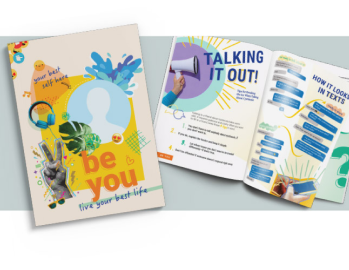
This booklet for your teen with cystinosis provides tips needed to juggle life, school, friends and cystinosis. Here they will get information like the importance of keeping their muscles moving, things to bring with them when they go out, the right sunglasses for their face shape, and much more!
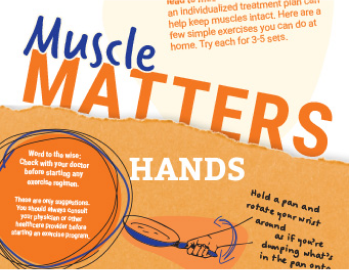
Cystine buildup in muscles may lead to muscle-wasting. Fortunately, cystine-depleting therapy helps keep muscles intact. So does exercise. Download this brochure to get a few simple exercises you can do at home.
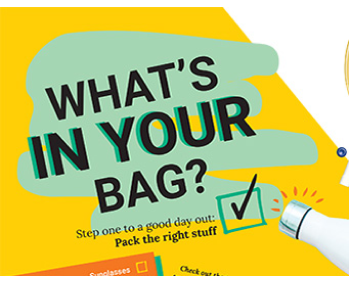
Check out the top things teens told us that they don’t leave home without!
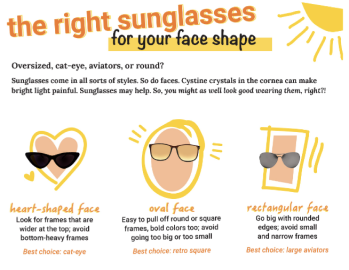
Sunglasses come in all sorts of styles. So do faces. Cystine crystals in the cornea can make bright light painful. Sunglasses may help. So, you might as well look good wearing them, right?!
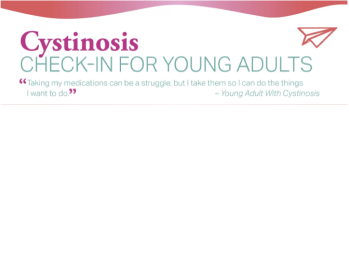
This downloadable brochure contains a brief questionnaire to track you progress over time, help you set goals, and guide you to take small steps toward more independence in managing cystinosis as you approach adulthood.
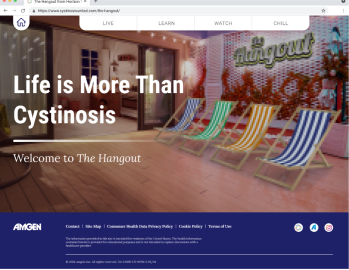

The Hangout is a place where your teens can go to help figure out life with and beyond cystinosis. They can get motivation, tips, and inspiration.
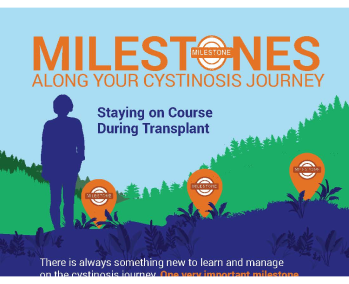
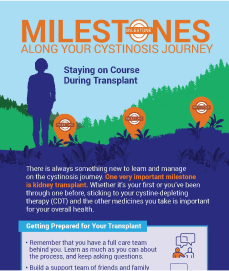
Whether you are getting ready for your first kidney transplant, or you have been through one before, use this guide to feel better prepared and informed.
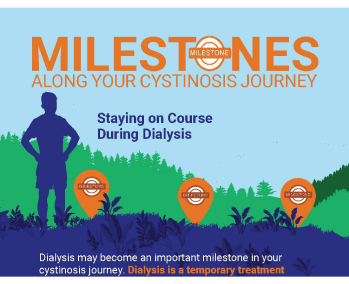
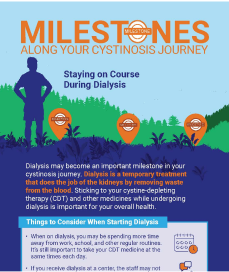
Dialysis may become an important milestone in your cystinosis journey. Use this guide to feel better prepared and informed and get helpful ideas on how to stay positive.
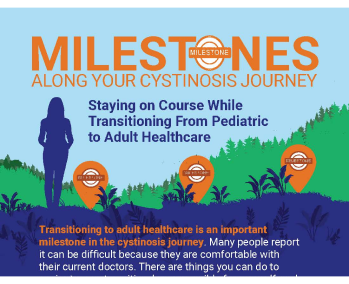
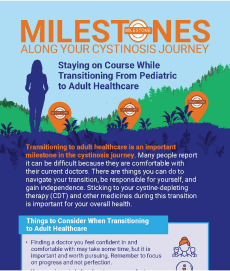
Transitioning to adult health care is an important milestone in the cystinosis journey. There are things you can do to help navigate your transition, be responsible for yourself, and maintain independence.
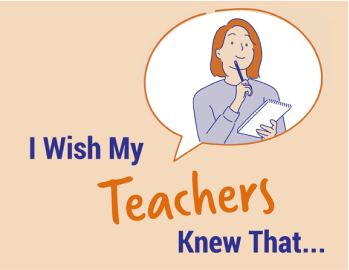
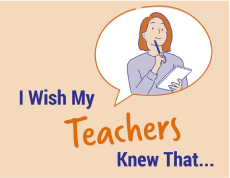
Have your child provide this handout to their teachers to help the staff better understand cystinosis and support your child’s needs.
Sometimes medical terms can be tough to understand. But learning the words used to talk about cystinosis may help you be clear with doctors, family, and friends. This glossary is a great place to start.
Amino acid: A building block of proteins used in every cell to help the body grow.
Cystine: The amino acid that builds up inside of cells when a person has cystinosis.
Cystine-depleting therapy (CDT): A treatment that works to reduce the buildup of cystine in cells. Learn how taking a CDT as prescribed may help keep cystine levels low around the clock.
Cystine level test: A blood test that measures the amount of cystine in white blood cells at a given time. There are two tests that can measure cystine levels: mixed leukocytes and granulocytes.
Dialysis: A medical treatment to clean the blood when the kidneys do not work as they should.
Fanconi syndrome: A kidney disorder that causes the body to lose important substances needed for good health. It causes extreme thirst and frequent peeing (urination).
Granulocyte: A type of white blood cell that is collected in a blood sample during cystine level testing.
Hypothyroidism: A condition in which the thyroid gland is unable to make enough thyroid hormone, causing the body to not work like it should. Common symptoms include, but are not limited to, slowed growth, tiredness, and weight gain.
Immune system: A group of cells that protect the body against attacks by germs.
Infertility: Inability to cause pregnancy (for men) or inability to get pregnant (for women). Women of childbearing age with cystinosis may become pregnant.
Kidney transplant: A surgery to place a healthy kidney from a donor into the body of a person with failing kidneys.
Leukocytes: Commonly referred to as white blood cells; a collection of cells that help the body fight infections. One of the two available cystine level tests collects leukocytes in a blood sample.
Lysosome: The part of a cell that acts as a “recycling center” by breaking down proteins into amino acids. This is the part of the cell where cystine becomes trapped and builds up in people with cystinosis.
Myopathy: A disease that affects the muscles, making a person feel very weak.
Nephropathic cystinosis: Cystinosis of the kidney; often called classic infantile cystinosis because its symptoms usually appear within a child's first year of life. This is the most common (95% of all cases) and most severe form of cystinosis.
Photophobia: In patients with cystinosis, a buildup of cystine in the eyes may result in light sensitivity, or the eye's inability to tolerate light. It may also cause eye pain and severe headaches.
Rickets: Softening and weakening of bones in children, usually caused by a lack of vitamin D (phosphate) in the body.
White blood cells (WBCs): Also called leukocytes; a collection of cells that help the body fight infections.
You are not alone. The resources below may help you meet others living with cystinosis, learn about advocacy programs, explain what cystinosis is, and much more.
Global Genes is a nonprofit advocacy organization for patients and families fighting rare and genetic diseases, including cystinosis. Its mission is to eliminate the challenges of rare disease.
An independent kidney patient organization, AAKP is dedicated to improving the lives and outcomes of kidney patients through education, advocacy, patient engagement, and patient communities.
Learn moreCRF supports research that aims to improve the quality of life of patients with cystinosis, find better treatments, and ultimately find a cure.
Learn moreDPC is a patient-led, nonprofit organization dedicated to improving dialysis patients’ quality of life by advocating for favorable public policy.
Miracle Flights is a nonprofit health and welfare organization providing financial assistance for medical flights so that seriously ill children may receive life-altering, life-saving medical care and second opinions from experts and specialists throughout the United States.
CRN is an all-volunteer, nonprofit organization dedicated to supporting and advocating for research, providing family assistance, and educating the public and medical communities about cystinosis.
The Cystinosis Foundation of New Jersey is a nonprofit advocacy organization devoted to increasing awareness of cystinosis and funding medical research related to treating and curing those with the condition.
AKF is a nonprofit organization serving the millions of Americans with kidney disease. American Kidney Fund helps people fight kidney disease and live healthier lives by providing a wide range of programs and services, including prevention activities, educational resources, and financial assistance.
Learn moreDiscover the many ways Amgen has supported people with cystinosis in Committed to the Cystinosis Community.